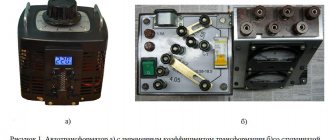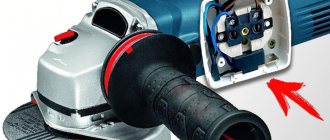What is a laboratory autotransformer (LATR)
Very often among electricians and electronics engineers the abbreviation LATR . Remember, we once looked at the power supply and even made it ourselves. The power supply gave us a constant voltage from zero to some final value, which, of course, depended on the steepness of the power supply. Agree, a very convenient thing. But there is one drawback - it only gives us constant voltage .
But, since there is a power supply for constant voltage, then there must be a power supply for alternating voltage . And such a power supply is called a laboratory autotransformer , or LATR . What is this thing and what is it eaten with?
LATR is the same transformer. It converts alternating voltage of one magnitude into alternating voltage of another magnitude . But the trick is that we can change the voltage at the LATR output if necessary.
Autotransformer device
There is one common winding located on the magnetic core of the LATR, and three additional terminals extend from it. Older autotransformer models have a current-collecting contact on the secondary winding, which allows:
- output voltage is smoothly adjustable;
- at one moment change one voltage value to another;
- change the heating intensity of the soldering iron tip;
- regulate electric lighting.
The most common type of autotransformer is a toroidal magnetic circuit. It is a ring-shaped core made of electrical steel.
Copper wire, or winding, is wound around the core. In addition, the design of the device has an additional tap - a tap from the winding. In total, there are exactly three contacts.
For large transformations, it is best not to use LATR. The reasons are as follows:
- The chances of resulting in a short circuit are too high. Electronic circuits specially adapted for this purpose or additional resistance will help deal with the problem.
- A conventional transformer is more suitable for many reasons, such as higher efficiency, lower steel costs, reduced dimensions and weight, and reduced tool costs.
Types of LATRs
Single-phase
This type of LATR produces single-phase alternating regulated voltage. It is very often used by radio amateurs, as it allows you to select any low-voltage alternating voltage.
Three-phase
This type of LATR is used in industrial electronics. A three-phase voltage is supplied to its input, and at the output we get the same three phases, but with a smaller amplitude. This LATR allows you to change the voltage amplitude of all three phases simultaneously . Roughly speaking, these are three single-phase LATRs, which are located in the same housing and which change the voltage equally.
What is the device
It is worth mentioning that laboratory autotransformers (LATR) were widely used half a century ago. Previous versions of the device had a current-collecting contact, which was located on the secondary winding. This made it possible to smoothly change the output voltage (its value).
If all kinds of laboratory instruments were connected, there was an option to quickly change the voltage. For example, if necessary, it was easy to influence the degree of heating of the soldering iron, adjust the brightness of the lighting, the speed of the electric motor, and much more. This is a kind of regulating power supply.
Figure 1. Scheme of a simple version of LATR.
The current version of LATR has various modifications. In general, it can be considered a transformer in which an alternating voltage of one value is transformed into an alternating voltage of another. The device is widely used as a voltage stabilizer. The main feature is the ability to change the voltage at the output of the device. LATRs come in several versions:
The three-phase version consists of three single-phase laboratory autotransformers mounted in a single housing. By the way, there are significantly fewer people who want to become the owner of a three-phase option.
Description of the work of LATRA RESANTA
Let's look at a single-phase LATR manufactured in Latvia RESANTA (read in Russian) brand TDGC2-0.5 kVA.
From above our LATR looks like this:
We see a regulator with which we can set the voltage we need.
On the front side we see some kind of alternating voltage voltmeter. We apply voltage from the 220 V network to the terminals on the left, and from the terminals on the right - the voltage that we currently require.
A simple device for regulation
There is a very simple version of LATR, which is available even for beginners; its diagram is shown in Fig. 1. The voltage range regulated by such a device is within 0-220 volts. This homemade regulator has a power of 25-500 W. The power of the device can be increased by installing thyristors VD1 and VD2 on radiators.
Semiconductor devices (we are talking about thyristors VD1 and VD2) should be connected in parallel with the load R1. The current they pass has opposite directions. When the device is connected to the network, the thyristors remain closed, unlike capacitors C1 and C2, which are charged by resistor R5. If there is a need, using resistor R5 you can change the voltage that is obtained during load. The resistor and capacitors create a phase-shifting circuit.
Figure 2. LATR with a bipolar transistor.
A phase-shifting circuit is an electrical four-port network, the harmonic signal at the output of which is shifted in phase relative to the input signal. They are common in self-propelled guns as adjustment devices that provide stability and the necessary quality of control. Special cases are differentiating and integrating chains.
This technical solution allows you to use not half the power for the load, but full power. This is achieved due to the fact that both half-cycles of alternating current are used.
The disadvantages include the form of alternating voltage at the load. In this version it is not strictly sinusoidal. The specific operation of semiconductor devices is the main reason. The presence of such a feature can cause interference in the network. But they can be eliminated by additionally installing chokes (series load filters) on the circuit. Such filters can be found even in a faulty TV.
How LATR works in practice
Let's conduct experiments with a 95 Watt 220 Volt incandescent light bulb. To do this, connect it to the output terminals on the right.
I wonder at what voltage the light bulb filament will start to glow? Let's find out! We turn the regulator until we notice a faint glow of the light bulb.
We look at the regulator scale. 35 Volts!
Did you know that in the USA the mains voltage is 110 Volts? I wonder how our light bulb would glow then? We set it to 110 Volts.
It glows, as they say, at full incandescence.
Now compare how it glows at 220 V
There is no point in increasing the voltage further. The light bulb may burn out.
If you want to set the voltage with great accuracy, then, of course, you can’t do without a multimeter. To do this, set the multimeter knob to the AC voltage measuring position.
We cling and measure the alternating voltage. At the same time, we adjust it using the LATR regulator. Exactly 110 Volts!
Application area
The features of the autotransformer allow it to be used in everyday life and various areas of industry.
Metallurgical production
Regulated autotransformers in metallurgy are used to check and adjust the protective equipment of rolling mills and transformer substations.
Utilities
Before the advent of automatic stabilizers, these devices were used to ensure the normal operation of televisions and other equipment. They consisted of a winding with a large number of taps and a switch. He switched the output of the coil, and the output voltage was controlled using a voltmeter.
Currently, autotransformers are used in relay voltage stabilizers.
Reference! In three-phase stabilizers, three single-phase autotransformers are installed, and adjustment is made in each phase separately.
Chemical and petroleum industry
In the chemical and petroleum industries, these devices are used to stabilize and regulate chemical reactions.
Safety precautions when working with LATR
I would also like to add a few words about safety precautions. There are LATRs without galvanic isolation . This means that the phase wire from the network goes directly to the output of such a LATR. The LATR circuit without galvanic isolation looks like this:
In this case, a network voltage of 220 Volts may appear at the output terminal of the LATR with a probability of 50/50. It all depends on how you plug the LATR mains plug into a 220 Volt socket.
If you look closely at the circuit diagram on the front panel of the LATR Resanta, you can see that the “X” and “x” terminals (the two bottom ones) are connected to each other by a conductor.
That is, if there is a phase on the “X” terminal, then there will also be a phase on the “x” terminal! You won’t measure the phase in the socket every time to insert the plug correctly, will you? Therefore, BE extremely CAREFUL! Try not to touch the LATR output terminals with your bare hands!
In principle, I touched it and nothing like that happened to me. The problem turned out to be that I have a wooden floor, which is almost a dielectric. I measured the voltage between me and the phase - about 40 Volts came out. That's why I didn't feel these 40 Volts. If I grabbed the battery with one hand or stood with my bare feet on the ground, and with the other hand grabbed the output “x” of the LATR, then I would be shaken very, very hard, since all the full 220 Volts would pass through me.
Voltage regulator: version with transformer
A laboratory autotransformer, which will not cause interference in the network and is capable of producing a sinusoidal voltage at the output, is a little more complicated than the previous one.
Its circuit (Fig. 2) contains a bipolar transistor VT1. It acts as a regulatory element in such a device. The power of this transistor is determined depending on the required load. In the circuit, it is connected in series with the load and functions as a rheostat. This option provides the ability to adjust the operating voltage during both active and reactive loads.
Unfortunately, there is a drawback here too. It lies in the fact that the activated control transistor generates too much heat. To eliminate it, you will need a heat sink that will have sufficient power. In this case, the area of such a radiator must be at least 250 cm².
Isolation transformer and LATR
There are also safer types of LATRs. They include an isolating transformer . The diagram of such a LATR looks something like this:
As we can see, the phase wire is isolated from the output terminals of such a LATR, thanks to a transformer, the operating principle of which you can read in this article. In this case we may be shaken if we set a high voltage at the output of the LATR using a twister and grab two output wires of the LATR at once. That is, there is a typical galvanic isolation .
Wire calculation
It is not advisable to use an autotransformer for large transformations for the following reasons:
- There is a high risk of receiving currents close to a short circuit. This is compensated by special electronic circuits or additional resistance. For small loads it is more profitable to use an electronic LATR.
- The advantages over transformers are lost: high efficiency, saving on conductor and steel, small dimensions and weight, cost.
We are determining within what limits the LATR will operate. We select 220 V for the network supply. We select 127, 180 and 250 V as secondary voltages. We limit the power to 300 W. You can choose your own values and make similar calculations using the example of this article.
The winding is calculated based on the larger current. The highest current will be when converting a voltage of 220 to 127 V. The autotransformer in this case is a step-down one, and circuit 1 is suitable for it. Based on the provided circuit, we calculate the maximum current I passing in the winding of both circuits:
I = I2 – I1 = P / U2 – P / U1 = 300 / 127 – 300 / 220 = 1 A
- where I, I2, I3 are currents in the corresponding sections of the circuit, A;
- P – power, W;
- U1, U2 – primary and secondary circuit voltages, V.
The wire diameter is calculated using the formula:
d = 0.8 * √I = 1 mm.
From Table 1, select the wire type and cross-section. We make the choice taking into account the calculated current and the average current density for transformers - 2 A/mm².
The LATR transformation coefficient n is calculated using the formula:
n = U1 / U2 = 220 / 127 = 1.73
For further calculation, we calculate the design power Pр:
Pр = P * k * (1 – 1/n) = 300 * 1.2 * (1 – 1/1.73) = 151.92 W
where k is a coefficient that takes into account the efficiency of the autotransformer.
To determine the number of turns per 1 volt, it is necessary to calculate the cross-sectional area of the core S and determine the type of magnetic circuit:
S = √ Pр = √ 151.92 = 12.325 cm²
W0 = m / S = 35 / 12.325 = 2.839
- where W0 is the number of turns per 1 volt;
- m – 50 for rod and 35 for toroidal magnetic cores.
If the steel is not of very high quality, it is worth increasing the W0 value by 20-30%. Also, when calculating turns, their number should be increased by 5-10% to avoid voltage sag. We calculate the number of turns for selected voltages 127, 180, 220 and 250 V:
w = W0 * U
We get 360, 511, 624 and 710 turns.
To calculate the length of the wire, we wrap one turn around the magnetic circuit and measure its length. Then we multiply by the maximum number of turns and add 25-30 centimeters for each terminal to the terminal.
Build process
To assemble an adjustable LATR, we select a toroidal magnetic core (Fig. 2). We insulate the place where the winding is applied with rag tape. We bring out the wire for the first power terminal. We bring out all subsequent wires without breaking them. We fix the first turn on the magnetic core and begin to wind the calculated amount. When a turn corresponding to one of the selected voltages is reached, we remove the loop and continue winding the wire. Figure 3 shows the winding process on a wooden frame.
After applying the winding, we varnish LATR. We fill the container with the selected varnish and dip the autotransformer into it. Leave to dry for a long time.
After drying, place the autotransformer in the housing. We connect the first output wire to the power connector. This connector must be electrically connected to the common load terminal, so we connect them together with some kind of conductor. We connect the loop output for 220 V to the second power terminal. We connect the remaining wires to the corresponding terminals of the secondary circuit. “Scheme” 2 shows the wire terminals.
For a laboratory autotransformer with a variable transformation ratio, we add a housing and make a mount for the regulator handle. We attach a slider with a carbon brush to the handle. The brush should touch the top of the winding tightly. We mark the area over which the brush will move, and in this place we get rid of the insulation. This way the brush will have direct electrical contact with the secondary winding. We replace the secondary voltage terminals, in addition to the common one, with one connected to a carbon brush (diagram 3). When connecting, secure the voltmeter.
If you follow the written article, you can easily make LATR with your own hands.











